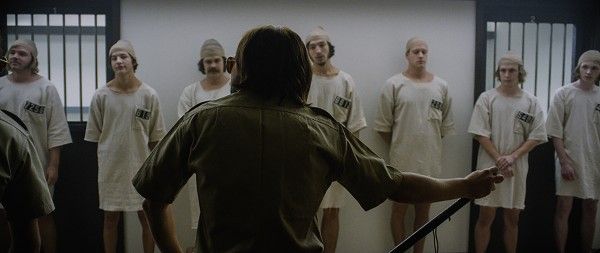Perhaps just as famous (or infamous) as Dr. Stanley Milgram’s “Obedience Experiment” is Dr. Philip Zimbardo’s “Stanford Prison Experiment.” Both experiments deal with the power of authority figures to coerce people into doing awful things. Both movies shake our confidence in how we would behave under the same circumstances, but while Experimenter struggles to find the drama in the story of a scientist and his well-known experiment, Kyle Patrick Alvarez’s The Stanford Prison Experiment has the benefit of a narrative, and even thought we know the outcome, he and his outstanding cast manage to move the characters and their story from a novelty to a nightmare.
In August 1971, Dr. Philip Zimbardo (Billy Crudup) and his team put out a newspaper ad looking for young men to join a two-week experiment where they were randomly divided into prisoners and guards. A floor in Jordan Hall on the Stanford campus is converted into a “prison” where offices are turned into cells, a broom closet is used for solitary confinement, and the majority of the prison is a hallway. There are only two rules: 1) Guards cannot physically harm prisoners; and 2) once the experiment begins, it can no longer be referred to as an experiment. It is now reality, and that reality quickly became horrifying as the guards become sadistic and find ways to assert their authority through verbal abuse, forced exercise, and humiliation. Zimbardo and his team watch in morbid fascination as power corrupts the guards and the prisoners’ psyches break.
Alvarez cleverly starts his film with comedy with the participants seeing the experiment as a game/role-play and an easy way to make $15 a day. The audience laughs along with the participants—all of who are unnamed and identified as either a guard or by a prison number. But Zimbardo and his team know that the experiment has an unsettling thesis, which is to observe how stripping away people’s individuality and installing a powerful institution can change an individual’s behavior. All it takes is a little imagination and some costumes and grown men will crumble. And even though the experiment spiraled out of control at a surprising rate, the director is patient with his story. Presumably, Alvarez knows most of his audience is aware of how the experiment turned out, so he chooses to slowly grind us down like the poor students who were randomly chosen to be inmates.
We have to soak in not only the relationship between the guards and prisoners, but also Zimbardo and his experiment, who unwittingly becomes a participant. He identifies himself as the “superintendent”, and grows monomaniacal in pushing for the experiment to continue even though it’s clear that his thesis has been proven. Zimbardo wants to see how far he can peek into the horrors of human behavior and as a result denies his complicity. We eventually feel as trapped as the prisoners since Zimbardo should function as the failsafe and instead becomes delusional in his belief that everything is in control.
The film is further supported by its tremendous collection of rising stars. Crudup might be the biggest name in the cast (and he’s great as always), but the supporting cast features a fine collection of up-and-comers, and their performances show you why they should be on your radar. Ezra Miller, Tye Sheridan, Johnny Simmons are tremendous as prisoners who think they can break the system only to experience an equal, opposite, and devastating reaction from the guards. Michael Angarano happily chews the scenery as a student who takes to playing a guard like a shark to blood. The experiment is designed to strip away at the individual identity of both the prisoners and the guards, but the actors keep us clinging to the remaining shreds of their personalities. We don’t know the characters’ names, but we care about all of them.
Alvarez took a direct experiment with a well-known conclusion, and still managed to make it captivating. So it’s disappointing that he undermines his confident direction by tacking on a completely unnecessary post-script that explains everything we just saw. The story has a clear endpoint, but then we get debriefed for the final three minutes like we couldn’t figure out what to feel or think.
The Stanford Prison Experiment endures because we know exactly what to feel and think. We feel disturbed and we rethink our identity. We know this before we even step into the theater, and The Stanford Prison Experiment succeeds because it brings our fears to life, and while Alvarez may have wanted to leave his audience with a breather, his film works far better when it’s making us gasp at humanity’s fragile morality.
Rating: B+
Click here for all of our Sundance 2015 coverage. Click on the links below for our other reviews:
Matt’s Reviews:
- The Bronze
- Cop Car
- The End of the Tour
- Experimenter
- Going Clear
- In Football We Trust
- The Mask You Live In
- Mississippi Grind
- Most Likely to Succeed
- Slow West
- Stockholm, Pennsylvania
- True Story
- White God
- Z for Zachariah
Adam’s Reviews


